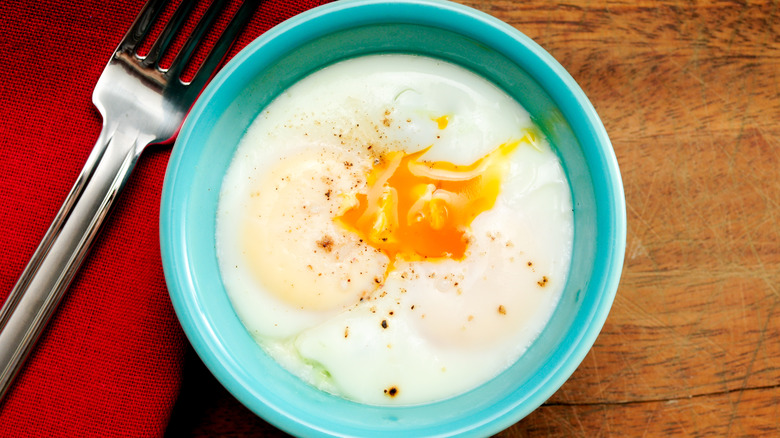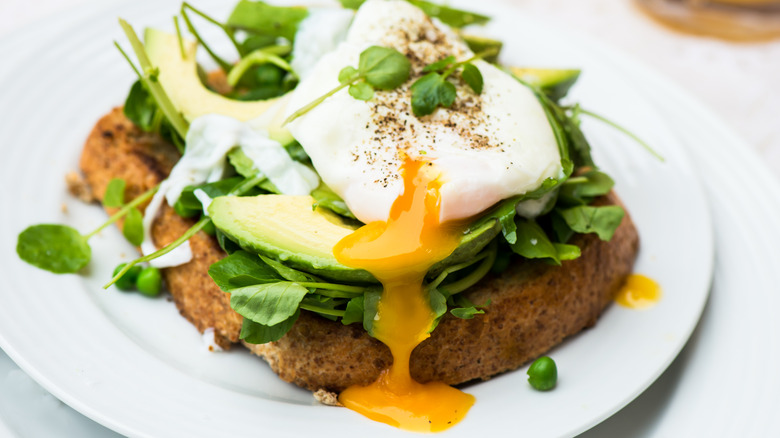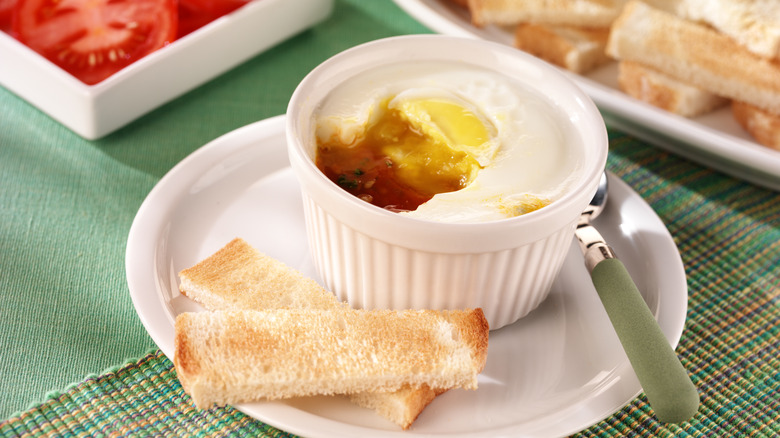How Coddled Eggs Differ From Poached Eggs
There may not be a more versatile kitchen ingredient than the egg. Eggs transition from breakfast to lunch to dinner and even dessert (chocolate soufflé, anyone?) with ease. Most people are familiar with the basic preparations: scrambled, boiled, fried, and over-easy. But in 1903, French culinary legend and pioneer Auguste Escoffier outlined 143 different ways to prepare eggs, per The Paseo Club. It sounds crazy, but when you think about it, eggs are essential in things like mayonnaise, custards, sauces like hollandaise, and even in some cocktails. The tiny, unassuming chicken egg is mightier than it looks. They appear in cuisine all over the world like shakshuka in the Middle East, Croque madame in France, egg curry in India, and huevos rancheros in Mexico.
According to World Population Review, per capita, the Japanese eat the most eggs in the world, with the average person consuming around 320 eggs per year. Considering eggs are affordable, nutritious and delicious, this is no great surprise. Egg preparation can range from the casual, to something dramatic and beautiful, like perfectly poached eggs over avocado toast, perfect for a hoity-toity brunch. A lesser-known cooking method that will get you a result similar to poaching is called coddling, believed to have originated in 1800's England, per Kitchn. So, could you substitute one method for the other? Not so much, it turns out.
What is a poached egg?
MasterClass explains that poaching will result in an egg whose white is cooked and yolk is runny. It is cooked outside the shell, not like a soft-boiled egg that is cooked inside the shell. The result of poaching is a tender cooked egg that maintains a round or domed shape. It tends to take the shape of whatever it's being served on, like eggs Benedict, and when sliced into, its yolk drapes down the food, looking gloriously appetizing.
To prepare a poached egg, start by bringing water to a gentle simmer. You're not looking for full-on boil, just enough heat for small bubbles to come to the surface of the water. Add some white vinegar to help the egg white fully set, per Masterclass. Meanwhile, crack an egg into a small dish or ramekin and set aside. When the water is simmering, stir it with a whisk or spoon until you get a vortex going, then gently slide the egg into the water and let it cook for about three minutes. Carefully take it out of the water with a slotted spoon or small strainer and use it as you wish.
What is a coddled egg?
Like a poached egg, a properly prepared coddled egg will have a cooked egg white with a runny yolk, according to The Spruce Eats. The difference is in its preparation. While a poached egg is cooked directly in hot water, a coddled egg is cooked in a ramekin, small jar or egg coddler which is placed inside a water bath, where the gentle transfer of heat through the ramekin cooks the egg. It is meant to be eaten right out of the cooking vessel, not taken out and placed on a plate. Most of the time, coddled eggs are prepared in the oven, but they can be cooked on the stove as well.
To prepare coddled eggs, Williams Sonoma suggests buttering your coddler or jar and cracking your eggs directly into them. Preheat your oven to 350 degrees, place your ramekins into a baking dish and pour enough hot water into the dish to come halfway up the sides. When the whites look fully set, the eggs can be eaten directly out of the jars with a spoon or alongside buttered toast. One of the best things about coddled eggs is that you can add lots of flavorings to the eggs either before they are cooked or after, such as cooked bacon, cheese, heavy cream, a knob of butter, onions, and other cooked vegetables. Whether you poach them or coddle them, your breakfast (lunch or dinner) will never be the same.


